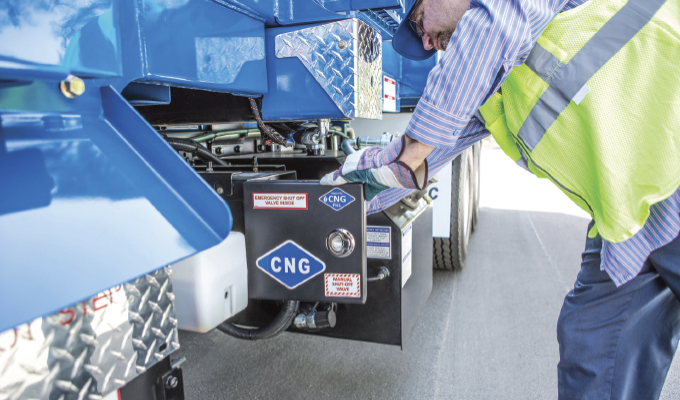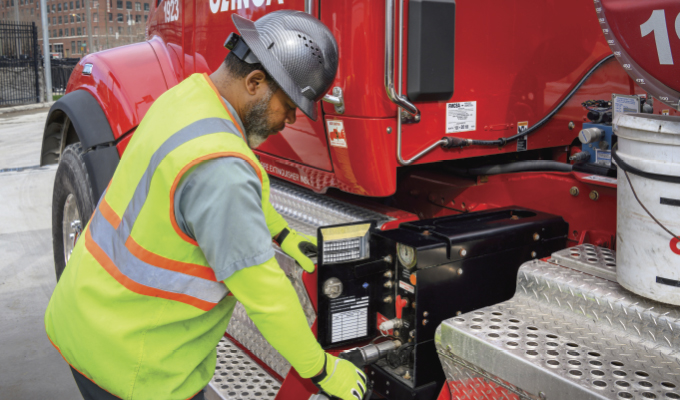Earlier this year, the Environmental Protection Agency (EPA) announced new emissions standards for heavy-duty trucks beginning with model years 2027 through 2032. The updated regulations provide fleets with a timeline of 2027-2030 to build out zero emissions infrastructure. The EPA also set targets for the percentage of new vehicles that will have to be built with zero emissions technology by 2032.
As explained in a statement by the Motor & Equipment Manufacturers Association, “the EPA final rule includes an amended and more comprehensive analysis of compliance pathways for a variety of propulsion technologies including plug-in hybrid, BEVs, hydrogen fuel cell electric vehicles (FCEV), hydrogen combustion (H2ICE), and other renewable fuel vehicles. This should allow for more technologies to achieve compliance.”
Previously, there was a perception that EVs were the primary pathway for commercial vehicle fleets to reach zero emissions. However, EV adoption remains in its infancy, with less than one percent of the globe, excluding China, having adopted the technology to date. Current projections indicate that global electric vehicle adoption will reach 10 percent by 2028. While there is significant interest in EVs, many work truck fleets are hesitant to adopt fully electric solutions at this time due to limited driving range, lack of sufficient charging infrastructure and the high purchase price of EVs.
As a result, alternative energy sources have gained momentum as solutions for OEMs and fleets to reduce emissions in the near term to meet upcoming changes to the EPA’s standards.
NATURAL GAS ENGINES DELIVER CLEANER, QUIETER OPERATION
Commercial vehicle fleets that use natural gas vehicles can significantly reduce their operating costs. Compressed natural gas (CNG) and liquified natural gas (LNG) are often less expensive than diesel fuel. Since natural gas in the U.S. is typically produced domestically, prices tend to be more stable than oil-based fuels. In addition, natural gas engines produce less soot and carbon build-up, leading to reduced maintenance needs and more time on the road.
One of the main concerns for fleets owners and drivers as they transition away from diesel fuel is if the change will negatively impact the performance of their vehicles. Pairing natural gas engines with fully automatic transmissions can maximize the performance of medium- and heavy-duty vehicles because they do not require power interrupts during range shifts, unlike manual and automated manual transmissions (AMTs). Fully automatic transmissions also multiply engine torque to significantly improve startability, drivability and overall productivity to compensate for the lower power and torque-per-cylinder displacement associated with CNG and LNG engines. This means vehicles will not suffer from the throttle-response delays seen with manual or AMTs.
Natural gas engines are cleaner and quieter than their diesel counterparts. Natural gas engines deliver significant noise reduction compared to a diesel-powered vehicle, leading to a better driver experience and reduced noise pollution. The alternative fuel also offers a variety of fuel benefits, which are amplified by fully automatic transmissions. The torque converter supports the engine during frequent start-stop duty-cycles, enabling peak fuel efficiency and reducing CO2 emissions.
S&P Global Mobility forecasts that sales of CNG vehicles will increase 63 percent by 2030. Natural gas vehicles have been in use for decades, enabling fleets to use reliable, familiar hardware to achieve sustainability goals and meet stricter environmental regulations.

HYDROGEN EMERGES AS PROMISING ALTERNATIVE ENERGY SOURCE
Hydrogen is another clean energy source that has successful use cases in commercial vehicle applications. Hydrogen can power both FCEV and H2ICE vehicles. In 2023, the federal government announced plans to invest $8 billion into regional clean hydrogen hubs to increase domestic production of the zero emissions fuel. This investment is spurring renewed interest in hydrogen as a clean energy solution for medium- and heavy-duty commercial vehicles.
In fuel cell applications, hydrogen can extend vehicle range and reduce on-board battery requirements. This enables zero emission operation while mitigating the range anxiety that often comes with BEVs. Like battery charging in EVs, hydrogen fueling infrastructure will need to expand to enable wide-scale adoption of this alternative fuel solution. However, building this infrastructure is expected to be as challenging, if not more challenging, than building a nationwide EV charging infrastructure to support commercial vehicles.
In terms of hydrogen combustion, engine manufacturers have invested in researching this topic significantly in recent years. Much like hydrogen FCEVs, hydrogen ICEs reduce carbon emissions, but this technology also allows OEMs to use familiar technology to manufacture vehicles. It also comes with a lower upfront adoption cost for fleets. Allison Transmission’s propulsion solutions have been successfully paired with hydrogen ICEs, and we’re collaborating with our OEM partners to explore this technology further as a viable solution for meeting EPA standards.
LOOKING AHEAD TO A ZERO EMISSIONS FUTURE
By incorporating vehicles powered by natural gas, propane, hydrogen fuel cell and other diesel-alternative fuel sources into their fleets, owners and operators can often use familiar hardware to achieve their sustainability goals. For example, propulsion solutions, including those designed and manufactured by Allison Transmission, are energy agnostic, meaning they can pair with several energy sources to achieve vehicle propulsion.
When planning for the upcoming changes to EPA’s emissions standards, one thing is clear, there will be no one-size-fits-all approach for commercial vehicles. It will be critical for vehicle, engine, and propulsion manufacturers to offer a broad portfolio of diesel-alternatives designed to meet the unique needs of customers. This will provide fleets the power of choice in selecting the energy source that best fits their vehicle and application.
ABOUT THE AUTHOR
Branden Harbin is the executive director, global marketing at Allison Transmission. To learn more, visit www.allisontransmission.com.




